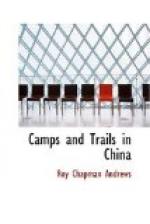the upper branches of a splendid tree. It
is the home of a great colony of red-bellied squirrels
(Callosciurus erythraeus subsp.) and after a
few moments of silence we see a flash of brown
along a branch, my gun roars out, and there is
a thud upon the ground.
Yvette runs to find the animal and ere the echoes have died away in the forest the gun bangs again. We have already shot a dozen squirrels from this tree and yet more are there. Sometimes a tiny, striped chipmunk (Tamiops macclellandi subsp.) will appear on the lower branches, searching the bark for grubs, and after he falls we have a long hunt to find him in the brown leaves. When it is too dark to see the squirrels, we wander slowly back to camp and eat a dinner of delicious broiled deer steak in front of the fire; over the coffee we smoke and talk of the day’s hunting until it is time to “run the traps.”
Of all the work we enjoy this most. With lanterns and a gun we pick our way among the trees until we strike the trail along which the traps are set. On the soft ground our feet are noiseless and, extinguishing the lanterns, we sit on a log to listen to the night sounds. The woods are full of life. Almost beside us there is a patter of tiny feet and a scurry among the dry leaves; a muntjac barks hoarsely on the opposite hillside, and a fox yelps behind us in the forest. Suddenly there is a sharp snap, a muffled squeal, and a trap a few yards away has done its work. Even in the tree tops the night life is active. Dead twigs drop to the ground with an unnatural noise, and soft-winged owls show black against the sky as they flit across an opening in the branches.
We light the lanterns again and pass down the trail into a cuplike hollow. Here there are a dozen traps and already half of them are full. In one is a tiny brown shrew caught by the tail as he ran across the trap; another holds a veritable treasure, and at my exclamation of delight Yvette runs up excitedly. It is a rare Insectivore of the genus Hylomys and possibly a species new to science. We examine it beside the lantern, wrap it carefully in paper, and drop it into a pocket by itself.
The next bit of cotton clings to a bush above a mossy log. The trap is gone and for ten minutes we hunt carefully over every inch of ground. Finally my wife discovers it fifteen feet away and stifles a scream for in it, caught by the neck and still alive, is a huge rat nearly two feet long; it too is a species which may prove new.
When the last trap has been examined, we follow the trail to the edge of the forest and into the clearing where the tents glow in the darkness like great yellow pumpkins. Ours is delightfully warmed by the charcoal brazier and, stretched comfortably on the beds, we write our daily records or read Dickens for half an hour. It is with a feeling of great contentment that we slip down into the sleeping bags and blow out the candles leaving the tent filled with the soft glow of the moonlight.




